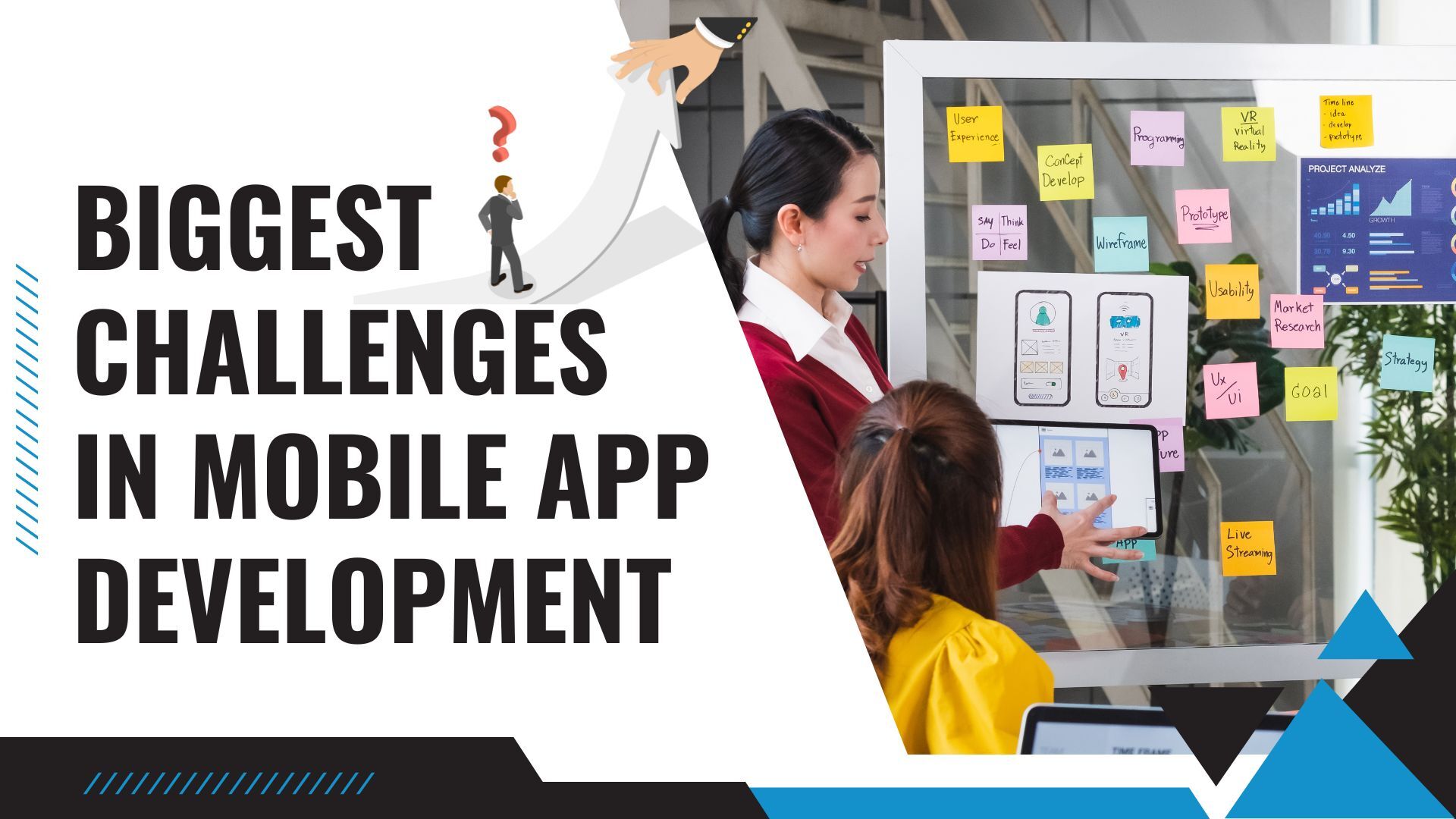The demand for mobile applications is surging – fueled by both business needs and user reliance on digital convenience. Yet, building a successful mobile app is not easy as it seems at the first glance.
Developers face a host of challenges in mobile app development that can derail a project if not carefully managed, including security concerns, performance issues, and user experience (UX) intricacies.
In this blog, we’ll dive into these key challenges and discuss effective ways to overcome them, ensuring a robust, high-performing, and user-friendly mobile app.
Top Challenges in Mobile App Development
The mobile app development process is fast-paced and demanding, often requiring developers to create solutions that are needed to cater diverse devices, operating systems, and user expectations. Here are the main challenges mobile developers commonly face:
1. Developing Cross Platform Applications
Cross-platform app development has improved significantly with frameworks like Flutter, React Native, and Xamarin, which simplify building apps for multiple platforms with one codebase.
While these tools have addressed many prevalent issues, challenges still exist.
Performance can lag compared to native apps, and achieving consistent platform-specific UI remains tricky. Accessing hardware features and platform-specific APIs can also be limited, sometimes requiring custom code for each platform.
Additionally, app size tends to be larger, and long-term compatibility can cause maintenance issues. Overall, cross-platform frameworks are now highly viable but certain limitations persist, particularly for complex, performance-intensive applications.
2. App Performance Optimization
Developing the same application for different operating systems and devices with varied hardware capabilities and memory management poses a major challenge in delivering consistent app performance.
OS like iOS and Android, has distinct memory handling and resource management techniques, and devices within these systems come with vastly different RAM, processors, and storage capacities, especially across price points. High-end devices may smoothly run complex features and animations, while entry-level devices could experience lag, crashes, or rapid battery drain under similar loads.
Ensuring an app delivers a nearly identical user experience across these diverse devices requires optimizing code, reducing memory usage, and tailoring performance to each hardware level.
3. Balancing Power Management and App Performance
Battery power is impacted by multiple combined factors like network strength, active sensors but the app architecture also contributes a significant role. Maintaining battery efficiency in mobile apps remains a challenge for developers.
App architecture significantly determines a smartphone’s power consumption, as it dictates how efficiently an app uses system resources like memory, and network connections. Inefficient architecture can lead to excessive background processes, frequent network requests, or continuous GPS use, all of which rapidly drain a device’s battery.
Developers also have to optimize app performance for low-powered devices/older devices by adopting lean architecture, and minimizing background activities. Strategies like using efficient algorithms, idle times, and tailoring processes to run only when necessary allow the app to deliver functionality without excessive battery usage.
4. Implementing Consistent and Smooth User Experience
Developers face a significant challenge in delivering a seamless User Experience(UX) in mobile apps across devices from various OEMs (Original Equipment Manufacturers), each with its own screen resolutions, aspect ratios, and unique design elements like camera cutouts or dynamic islands. This diversity creates a fragmented environment where user interface elements may appear inconsistent or misaligned if not properly optimized, leading to a broken user experience UX feels disjointed, it can lead to dissatisfaction and even prompt users to abandon the app altogether. This complexity makes it essential for developers to anticipate and adapt to various screen configurations to maintain a consistent and enjoyable experience across all devices.
5. Maintaining App Data Security
Applications often handle sensitive user information—like personal data, payment details, and location data—making security a must necessity. This is why dealing with app development security challenges is a complex maneuver for developers, especially in the current scenario where cyber attack is an everyday phenomenon.
Developers who are responsible for app security must stay alert against risks such as data breaches, unauthorized access, and malware attacks. This requires implementing multiple layers of protection, including encryption, secure authentication methods, and regular security audits.
Balancing strong security with a seamless user experience is tricky, as overly complex security measures can frustrate users, while lenient ones can expose them to risks. It’s a continual effort to safeguard data and stay a step ahead of potential threats.
6. Optimizing Apps To Work With Slow Network Connectivity
Network connectivity is a major challenge in app development, particularly for applications that need to function smoothly in areas with limited or slow internet access, like remote regions with only 2G or 3G connections or where Wi-Fi speeds are inconsistent.
In these environments, ensuring that the app can load quickly and operate effectively becomes a significant technical hurdle. Apps that rely heavily on data or require constant connectivity can experience lag or even fail to load, which frustrates users and disrupts their experience. To tackle this, developers must optimize app performance by reducing data load, compressing images, enabling offline functionality where possible, and adopting adaptive design practices that can dynamically adjust to available bandwidth.
These optimizations, though critical, add layers of complexity to the development process, as developers have to balance delivering rich features with the need for efficient data use. Ensuring an app’s functionality in low-connectivity situations ultimately requires creative solutions and meticulous testing, but it’s essential for creating a reliable user experience that isn’t dependent on perfect internet conditions.
7. Third-Party API Integrations
APIs can offer valuable functionalities—like payment processing, social media integration, or data analytics—incorporating them is rarely straightforward. Integrating third-party APIs into an app is often a demanding and intricate task for developers.
Each third-party API has its own documentation, authentication requirements, and unique quirks that developers need to carefully understand and adapt to. Compatibility issues are common, especially when APIs update their versions, change endpoints, or deprecated functions, which can lead to unexpected bugs and downtime in the app.
APIs often come with rate limits that restrict the number of calls allowed within a set period, making it essential to optimize data requests to avoid performance slowdowns or service interruptions. Debugging also becomes more challenging, as errors from third-party services can be difficult to trace and solve due to limited control over external servers.
Despite these challenges, developers must invest time and effort into integrating APIs seamlessly, as they are crucial to enhancing the app’s functionality and delivering a richer user experience.
8. Keeping Mobile Apps Functional To Work With Updated Operating System
Ensuring that an app continues to function smoothly after each operating system (OS) update is a significant challenge for developers. Every OS update can introduce new features, change existing functionalities, or alter system permissions, all of which may impact an app’s performance or compatibility.
In some cases, previously reliable components may suddenly cause issues, from UI glitches to app crashes, due to underlying changes in the OS. To keep up, developers must frequently test their app against beta versions of new OS updates and adapt their code accordingly. This often requires quick fixes or even extensive rewrites to align with the latest OS requirements. Additionally, maintaining compatibility across multiple OS versions, especially with different behaviors on Android and iOS, adds complexity to the process. If an app isn’t updated promptly, users may experience poor performance or bugs, leading to potential frustration and a drop in user satisfaction. Staying ahead of OS updates, while time-consuming, is crucial for delivering a consistent and stable user experience across all devices.
9. App Visibility In The Store
Getting an app noticed in the app store remains one of the biggest challenges in app development. With millions of apps available across Google Play and the Apple App Store, the competition for visibility is fierce, and even a well-designed app can go unnoticed without strategic promotion.
App Store Optimization (ASO)—which involves optimizing titles, keywords, descriptions, and visuals—can help improve an app’s ranking, but it’s only part of the equation. Paid advertising, influencer partnerships, and social media marketing are often needed to drive initial downloads and build momentum.
For developers, the challenge is not only in creating a high-quality app but also in navigating these complex marketing landscapes to make sure it reaches the right audience and stands out among countless competitors.
Conclusion
Nowadays, smartphones are available at every price point, making it pocket friendly. This rise in smartphone availability has allowed businesses to ride the mobile app development.
But mobile app development brings multiple challenges. From security risks and performance issues to privacy concerns and battery efficiency. By addressing these challenges with a proactive, user-centered approach, developers can build mobile apps that are not only secure and efficient but also enjoyable to use.
While challenges in mobile app development are inevitable, the right strategies and best practices with the help of Logic-square Technologies can turn them into opportunities for creating robust, high-performing, and user-friendly apps that stand out in today’s competitive market.





